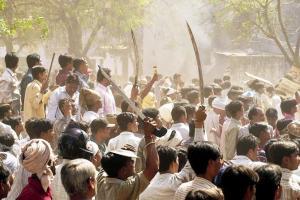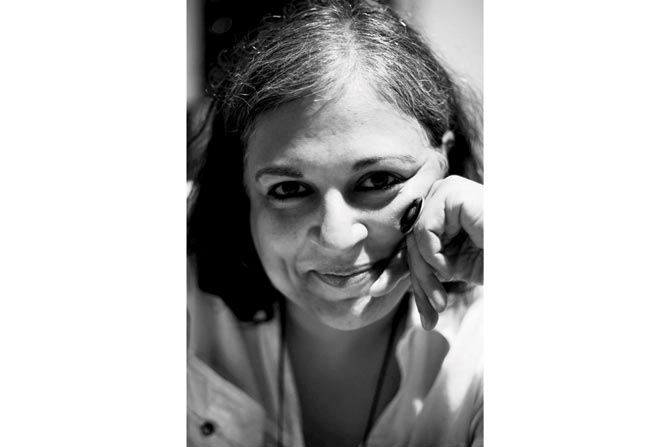A new book revisits the Gujarat riots of 2002 through the lens of its perpetrators

A Hindu mob waving swords at an opposing mob during the communal riots in Gujarat in 2002. Pic/Getty Images
It was in 2003, a year after the mass violence in Gujarat, which left 1,044 people dead - a majority of whom were Muslims - that Delhi-based Revati Laul arrived in the state, as correspondent for a mainstream television news channel. Wounds from the previous year still fresh, Laul remembers the tension that hung in the air.
ADVERTISEMENT
Yet, the sweeping sentiment was anything, but that of regret. "Everywhere I went, people would tell me, 'behen, you will not understand why we supported the bawal [riot]'," she recalls. "I started to ask myself what was it that made so many people support this mob." This, she says, wouldn't have been possible, without understanding the personal motivations of the perpetrators of these crimes. "If we really want to change this politics [of hate], we can't keep focusing on the victims, because, in doing so, we'd only end up polarising this space further," she says, in a telephonic interview.

Revati Laul
Her new book, The Anatomy of Hate (Context, Westland Publications), is an attempt to revisit the concomitant riots that followed the burning of the 59 karsevaks on a train in Godhra, but through the lens of three men - Suresh 'Langdo' Jadeja, Pranav (name changed) and Dungar, who brazenly extended support to the violence that tore through Gujarat. But it doesn't end or begin here.
Laul, now an independent journalist, who has been covering politics for over 20 years, gives us the back-stories to the events and experiences that shaped their violent streak, and the aftermath of it. The fulcrum of her narrative, she says was Pranav, whom she came across somewhere in 2005. "I ran into Pranav at a workshop [that I was covering], where historian Ram Puniyani was discussing polarisation and violence. I remember turning my camera to the first person sitting in front of me, and asked him, 'What do you think about all of this?' And he said, 'My way of thinking has changed entirely'. I wasn't expecting that."
This man happened to be Pranav, a student of Social Sciences, when the riots broke out. Initially scared about the goings-on, he became party to the violence with fellow hostel mates, ransacking and looting shops. "It wasn't like we wanted them [Muslims] to die or anything like that. We were just caught up in the swing of things and felt we weren't responsible for their fate," he later told Laul, in an interview, for which she pursued him for nearly 10 years, before he agreed to be part of her book. Pranav was interesting, because he underwent a metamorphosis. "In his story, we see that after cheering on the destruction of Muslims, he later gets a job at an NGO that is rehabilitating them. That for me is the pivot of the book. Because it's important to know what happened [to the perpetrators] after [the riots]."
The same cannot, however, be said of Suresh, whose story is unarguably the most gut-wrenching. He was part of the mob that spearheaded the massacre at Naroda Patiya, in Ahmedabad. Of the many horrifying incidents involving him, Laul writes of how a Muslim man was told of his heavily-pregnant wife being circled by Suresh and his gang. They ripped out the foetus within her, and killed it, before murdering her. His story was the only one relayed to Laul through those known around him - his Muslim wife, Farzana Bano, in particular, whom he married only to seek revenge from the community, against whom his hate had been piling up. "Suresh is a character for which there is no redemption in the book. But this wasn't a story of redemption anyway. It was a quest to understand where the mob comes from, and re-populate these areas and try and find out why they have fallen off the map," says Laul.
Suresh, for instance, belonged to the tribe of the Charras. They owed their notoriety to a law put in place in 1871 by the British. "The colonisers were terrified of nomadic tribes like the Chharas and their constant movement, especially after the Great Revolt of 1857. So they labelled them 'criminal tribes'," Laul writes in the book. It was only five years after Independence that the law was denotified.
"But even after they became free, the social and economic stigma against them continued," Laul says, now. "If we don't want another Suresh to happen, we have to change how we look at the Chharas or others like them," says the author. "For me, this book was not to show the heinousness of their crimes. It wasn't meant to be a voyeuristic exercise. I just wanted to know where extreme violence comes from. It comes from us, it comes from us absenting people and pushing them to the point, till they lead the kind of life that we cannot imagine ourselves living."
Catch up on all the latest Mumbai news, crime news, current affairs, and also a complete guide on Mumbai from food to things to do and events across the city here. Also download the new mid-day Android and iOS apps to get latest updates
 Subscribe today by clicking the link and stay updated with the latest news!" Click here!
Subscribe today by clicking the link and stay updated with the latest news!" Click here!






